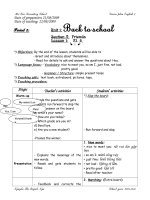Intro to chem unit 1
Bạn đang xem bản rút gọn của tài liệu. Xem và tải ngay bản đầy đủ của tài liệu tại đây (1.51 MB, 36 trang )
Introduction to Chemistry
Chemistry
The study of:
the composition
(make-up) of
matter
the changes that
matter
undergoes
The 5 Traditional Branches of Chemistry
Inorganic
Organic
Analytical
Physical
Biochemistry
Inorganic Chemistry
The study of chemicals that do not
contain carbon.
Organic Chemistry
The study of chemicals that contain
carbon.
Origin: study of chemicals in living
organisms.
Analytical Chemistry
Composition of matter; measurable,
identifies compounds/components
Example:
Mass Spectrometer
Gas Chromatograph
/>
Physical Chemistry
The study of :
The mechanism
The rate
The energy transfer that happens when
matter undergoes change.
Study of the interaction between two
elements
Study of properties and changes of
matter and energy
Biochemistry
Study of processes that take place
in organisms.
Understand the structure of matter
found in the human body and the
chemical changes that occur in cells
Science
What?
Why?
How?
When?
Science and Technology
Theoretical Chemistry-Design of new compound
and new ideas; 2 categories: pure and applied
Science Pure
Does not necessarily have an application;
just knowing for knowledge’s sake;
research
Technology Applied
Has practical applications in society
Directed toward a practical
goal/application
Engineering
Alchemists (~300BC-1650 AD)
China, India, Arabia, Europe, Egypt
•Aiming to:
Change common
metals to gold.
Develop
medicines.
•Developed lab
equipment.
•Mystical.
Antoine Lavoisier
(France 1743-1794)
Regarded as the Father of Chemistry
Designed equipment
Used observations
and measurements.
Discovered nitrogen
Law of Conservation
of Mass
The Scientific Method
Steps followed during
scientific investigations
Logical, problem solving
technique
Fathers of the scientific
method is Galileo Galilei and
Francis Bacon
Scientific Method
Observation- recognition of a problem
Visible or provable fact
From that a question arises (problem
statement)
Problem statement is a question that compares
variables
Example: Does the amount of salt in water affect
the boiling temperature of water?
Scientific Method
Hypothesis- a proposed explanation of an
observation
an educated guess
must be testable
Is a statement NOT a question that expresses the
expected answer to the problem statement (what
you think the results of the experiment will show)
If you increase the amount of salt added to the
water, the boiling temperature will also increase
because
Scientific Method
Experiment- an organized procedure used to
test a hypothesis (measurement, data
collection, manipulated and responding
variables)
Planned way to test the hypothesis and find out the
answer to the problem posed
Way to collect data and determine the value of the
dependent variable
Compares independent variable to the dependent
variable
Can only test one dependent variable at a time
Scientific Method
3 parts to an experiment
Control-standard for comparison
Variables
Independent Variable
Dependent Variable
Constants-parts of your experiment
that do not change
Scientific Method
Independent Variable
A variable that changes unrelated to other factors
A variable we manipulate, change, on purpose
A variable whose value we know before we start an
experiment
Example: Does the amount of salt in water affect
the boiling temperature of water? We know how
much salt we add to each amount of water before
boiling so amount of salt is the independent variable
Scientific Method
Dependent Variable
A variable that changes depending on some other
factors
The variable we are trying to find out
Variable whose value we do not know before we start
the experiment
Example: Does the amount of salt in water affect
the boiling temperature of water? We do not know
the boiling temperature to water once salt is added;
must test to find this out
Scientific Method
Constants
Does not change for the duration of the
experiment
Remains the same
Example: Does the amount of salt in
water affect the boiling temperature of
water? We would not change the brand
of salt or the amount of water (or type
of water)
Scientific Method
Analyze
Look for patterns in experimental
data
2 types of data
Quantitative = numbers
Qualitative = observations
Data presented via tables or graphs
3 types of graphs: circle (pie), bar, line
Scientific Method
The cafeteria wanted
to collect data on
how much milk was
sold in 1 week. The
table shows the
results. We are
going to take this
data and display it in
3 different types of
graphs.
Day
Chocolate
Strawberry
White
Monday
Tuesday
Wednesday
Thursday
Friday
53
72
112
33
76
78
97
73
78
47
126
87
86
143
162
Scientific Method
Bar Graph
A bar graph is used to
show relationships
between groups.
The two items being
compared do not need
to affect each other.
It's a fast way to show
big differences. Notice
how easy it is to read a
bar graph.
Often used for
counting.
Chocolate Milk Sold
120
112
100
Amount Sold
80
76
72
60
53
40
33
20
0
Monday
Monday
Wednesday
Friday
Tuesday
Tuesday
Thursday
Wednesday
Day
Thursday
Friday
Scientific Method
Circle graph (a.k.a.
pie chart)
Used to show how a
part of something
relates to the whole.
This kind of graph is
needed to show
percentages
effectively.
Sum of parts is 1 or
100%
Chocolate Milk Sold
Monday
Tuesday
Wednesday
Thursday
Friday
Scientific Method
Line Graph
A line graph is used
to show continuing
data; how one thing is
affected by another.
It's clear to see how
things are going by
the rises and falls a
line graph shows.
Equation of line
represents the data.
Chocolate MIlk Sold
120
100
Amount Sold
80
60
40
20
0
Monday
Tuesday
Wednesday
Day
Chocolate
Thursday
Friday









